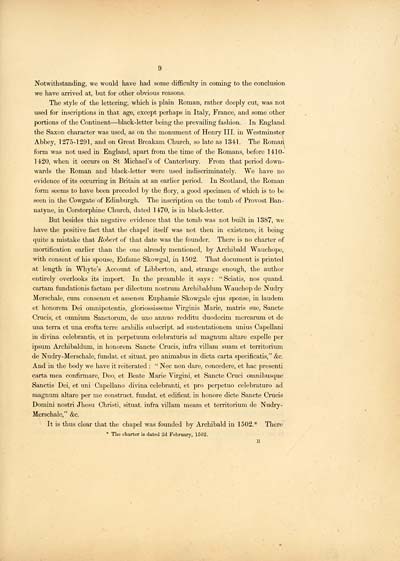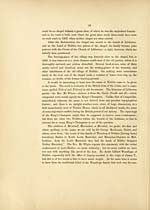Download files
Complete book:
Individual page:
Thumbnail gallery: Grid view | List view

9
Notwithstanding, we would have had some difficulty in coming to the conclusion
we have arrived at, but for other obvious reasons.
The style of the lettering, which is plain Roman, rather deeply cut, was not
used for inscriptions in that age, except perhaps in Italy, France, and some other
portions of the Continent — black-letter being the prevailing fashion. In England
the Saxon character was used, as on the monument of Henry III. in Westminster
Abbey, 1275-1291, and on Great Breakam Church, so late as 1341. The Romah
form was not used in England, apart from the time of the Romans, before 1410-
1420, when it occurs on St Michael's of Canterbury. From that period down-
wards the Roman and black-letter were used indiscriminately. We have no
evidence of its occurring in Britain at an earlier period. In Scotland, the Roman
form seems to have been preceded by the flory, a good specimen of which is to be
seen in the Cowgate of Edinburgh. The inscription on the tomb of Provost Ban-
natyne, in Corstorphine Church, dated 1470, is in black-letter.
But besides this negative evidence that the tomb was not built in 1387, we
have the positive fact that the chapel itself was not then in existence, it being
quite a mistake that Robert of that date was the founder. There is no charter of
mortification earlier than the one already mentioned, by Archibald Wauchope,
with consent of his spouse, Eufame Skowgal, in 1502. That document is printed
at length in Whyte's Account of Libberton, and, strange enough, the author
entirely overlooks its import. In the preamble it says : " Sciatis, nos quand.
cartam fundationis factam per dilectum nostrum Arcbibaldum Wauchop de Nudry
Merschale, cum consensu et assensu Euphamie Skowgale ejus sponse, in laudem
et honorem Dei omnipotentis, gloriossisseme Virginis Marie, matris sue, Sancte
Crucis, et omnium Sanctorum, de uno annuo redditu duodecim mercarum et de
una terra et una crofta terre arabilis subscript, ad sustentationem unius Capellani
in divina celebrantis, et in perpetuum celebraturis ad magnum altare capelle per
ipsum Archibaldum, in honorem Sancte Crucis, infra villain suam et territorium
de Nudry-Merschale, fundat. et situat. pro animabus in dicta carta specificatis," &c.
And in the body we have it reiterated : " Nee non dare, concedere, et hac presenti
carta mea confirmare, Deo, et Beate Marie Virgini, et Sancte Cruci omnibusque
Sanctis Dei, et uni Capellano divina celebranti, et pro perpetuo celebraturo ad
magnum altare per me construct, fundat. et edificat. in honore dicte Sancte Crucis
Domini nostri Jhesu Christi, situat. infra villam meam et territorium de Nudry-
Merschale," &c.
It is thus clear that the chapel was founded by Archibald in 1502.* There
* The charter is dated 2d February, 1502.
Notwithstanding, we would have had some difficulty in coming to the conclusion
we have arrived at, but for other obvious reasons.
The style of the lettering, which is plain Roman, rather deeply cut, was not
used for inscriptions in that age, except perhaps in Italy, France, and some other
portions of the Continent — black-letter being the prevailing fashion. In England
the Saxon character was used, as on the monument of Henry III. in Westminster
Abbey, 1275-1291, and on Great Breakam Church, so late as 1341. The Romah
form was not used in England, apart from the time of the Romans, before 1410-
1420, when it occurs on St Michael's of Canterbury. From that period down-
wards the Roman and black-letter were used indiscriminately. We have no
evidence of its occurring in Britain at an earlier period. In Scotland, the Roman
form seems to have been preceded by the flory, a good specimen of which is to be
seen in the Cowgate of Edinburgh. The inscription on the tomb of Provost Ban-
natyne, in Corstorphine Church, dated 1470, is in black-letter.
But besides this negative evidence that the tomb was not built in 1387, we
have the positive fact that the chapel itself was not then in existence, it being
quite a mistake that Robert of that date was the founder. There is no charter of
mortification earlier than the one already mentioned, by Archibald Wauchope,
with consent of his spouse, Eufame Skowgal, in 1502. That document is printed
at length in Whyte's Account of Libberton, and, strange enough, the author
entirely overlooks its import. In the preamble it says : " Sciatis, nos quand.
cartam fundationis factam per dilectum nostrum Arcbibaldum Wauchop de Nudry
Merschale, cum consensu et assensu Euphamie Skowgale ejus sponse, in laudem
et honorem Dei omnipotentis, gloriossisseme Virginis Marie, matris sue, Sancte
Crucis, et omnium Sanctorum, de uno annuo redditu duodecim mercarum et de
una terra et una crofta terre arabilis subscript, ad sustentationem unius Capellani
in divina celebrantis, et in perpetuum celebraturis ad magnum altare capelle per
ipsum Archibaldum, in honorem Sancte Crucis, infra villain suam et territorium
de Nudry-Merschale, fundat. et situat. pro animabus in dicta carta specificatis," &c.
And in the body we have it reiterated : " Nee non dare, concedere, et hac presenti
carta mea confirmare, Deo, et Beate Marie Virgini, et Sancte Cruci omnibusque
Sanctis Dei, et uni Capellano divina celebranti, et pro perpetuo celebraturo ad
magnum altare per me construct, fundat. et edificat. in honore dicte Sancte Crucis
Domini nostri Jhesu Christi, situat. infra villam meam et territorium de Nudry-
Merschale," &c.
It is thus clear that the chapel was founded by Archibald in 1502.* There
* The charter is dated 2d February, 1502.
Set display mode to:
![]() Universal Viewer |
Universal Viewer | ![]() Mirador |
Large image | Transcription
Mirador |
Large image | Transcription
Images and transcriptions on this page, including medium image downloads, may be used under the Creative Commons Attribution 4.0 International Licence unless otherwise stated. ![]()
| Histories of Scottish families > History and genealogy of the family of Wauchope of Niddrie-Merschell > (17) Page 9 |
|---|
| Permanent URL | https://digital.nls.uk/95384511 |
|---|
| Description | A selection of almost 400 printed items relating to the history of Scottish families, mostly dating from the 19th and early 20th centuries. Includes memoirs, genealogies and clan histories, with a few produced by emigrant families. The earliest family history goes back to AD 916. |
|---|

